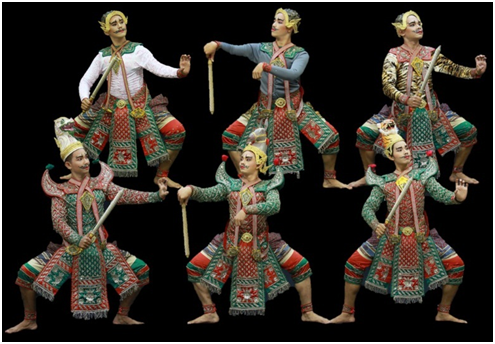การสร้างสรรค์การแสดง ชุด ระบำพลอสุราอุณาราช
คำสำคัญ:
การแสดงสร้างสรรค์, พลอสุราอุณาราช, ระบำบทคัดย่อ
การสร้างสรรค์การแสดง ชุด ระบำพลอสุราอุณาราช มีวัตถุประสงค์เพื่อศึกษาประวัติความเป็นมาของท้าวอุณาราช ตามบทละครเรื่องรามเกียรติ์ พระราชนิพนธ์ในพระบาทสมเด็จพระพุทธยอดฟ้าจุฬาโลกมหาราช ที่สอดคล้องกับความเชื่อเรื่อง ท้าวกกขนากและเขาวงพระจันทร์ในตำนานเมืองลพบุรี และเพื่อนำมาสร้างสรรค์การแสดงระบำพลอสุราอุณาราช จากการศึกษาพบว่า พลยักษ์ของอุณาราชมีลักษณะรูปร่างไม่เหมือนกันกับพลยักษ์ทั่วไปในเรื่องรามเกียรติ์ ประกอบด้วย 6 หมู่ ดังนี้ หมู่ที่ 1 หน้า เป็นเสือ กายเป็นยักษ์ หมู่ที่ 2 หน้าเป็นยักษ์ กายเป็นเสือ หมู่ที่ 3 หน้าเป็นม้า กายเป็นยักษ์ หมู่ที่ 4 หน้าเป็นยักษ์ กายเป็นม้า หมู่ที่ 5 หน้าเป็นสิงห์ กายเป็นยักษ์ หมู่ที่ 6 หน้าเป็นยักษ์กายเป็นสิงห์ ผู้สร้างสรรค์ได้นำข้อมูลทั้งหมดจากวรรณกรรมและงานวิจัยที่เกี่ยวข้องมาสร้างสรรค์การแสดง มีลำดับขั้นตอนการแสดงแบ่งเป็น 4 ช่วง คือ ช่วงที่ 1 “การรำออก” ผู้แสดงรำออกด้านหน้าเวทีด้วยเพลงหน้าพาทย์รัวสามลา ช่วงที่ 2 “การรำแนะนำตัวแสดง” ผู้แสดงรำตีบทตามคำร้องประกอบทำนองเพลงเขมรปากท่ออัตราจังหวะชั้นเดียว ช่วงที่ 3 “กระบวนการจัดทัพ” ผู้แสดงรำเพลงกราวใน ช่วงที่ 4 “การเดินทัพ” ผู้แสดงรำเพลงเชิด ดนตรีที่ใช้เป็นวงปี่พาทย์เครื่องคู่ เครื่องแต่งกายเป็นลักษณะแต่งกายแบบยืนเครื่องเสนายักษ์ ถ้าผู้แสดงมีกายเป็นยักษ์ มีหน้าเป็นสัตว์ จะสวมเครื่องแต่งกายแบบยืนเครื่องเสนายักษ์ สวมเสื้อสีแดง หรือสีเขียว ถ้าตัวแสดงมีกายเป็นสัตว์ มีหน้าเป็นยักษ์ จะสวมเครื่องแต่งกายแบบยืนเครื่องเสนายักษ์ สวมเสื้อตามลักษณะของสัตว์ประเภทนั้น ๆ ผู้แสดงสวมศีรษะเปิดหน้าแบบหน้าแขวะและเขียนหน้า ตัวแสดงทุกตัวสวมศีรษะที่มีลักษณะเดียวกัน มีการเขียนหน้าเพื่อให้เห็นความสวยงามของศิลปะการแต่งหน้าโขน ท่ารำที่ใช้ในการแสดงใช้ท่ารำแม่ท่ายักษ์เป็นหลัก ผสมกับลักษณะและกิริยาของสัตว์ตามบทละคร ถ้าตัวแสดงมีกายเป็นยักษ์ มีหน้าเป็นสัตว์ ใช้ท่ารำหลักเป็นท่ายักษ์ มือและเท้าเป็นลักษณะของยักษ์ แต่มีกิริยาเหมือนสัตว์ประเภทนั้น ๆ ถ้าตัวแสดงมีกายเป็นสัตว์ มีหน้าเป็นยักษ์ จะใช้ท่ารำตามกิริยาของสัตว์ ส่วนมือและเท้าเป็นลักษณะของสัตว์ แต่มีความเข้มแข็งเหมือนยักษ์ มีระเบียบเหมือนกองทัพเตรียมออกศึก
เอกสารอ้างอิง
กรมศิลปากร. (2551). ทะเบียนข้อมูล : วิพิธทัศนา ชุดระบำ รำ ฟ้อน เล่ม 3. กรุงเทพฯ: อมรินทร์พริ้นติ้งแอนด์พับลิชชิ่ง.
จินตนา สายทองคำ. (2558). นาฏศิลป์ไทย รำ ระบำ ละคร โขน. นครปฐม : สถาบันบัณฑิตพัฒนศิลป์.
พระบาทสมเด็จพระพุทธยอดฟ้าจุฬาโลก. (2558). บทละครเรื่องรามเกียรติ์ เล่ม 2 (พิมพ์ครั้งที่ 11). กรุงเทพฯ: แสงดาว.
ราชบัณฑิตยสถาน. (2554). พจนานุกรมฉบับราชบัณฑิตยสถาน พ.ศ. 2554. กรุงเทพฯ: นานมีบุ๊คส์พับลิเคชั่นส์.
วรวิทย์ วงษ์สุวรรณ์. (2556). ตำนานเมืองลพบุรี (พิมพ์ครั้งที่ 2). สระบุรี : ปากเพรียวการช่างจำกัด.
สุรพล วิรุฬห์รักษ์. (2547). หลักการแสดงนาฏยศิลป์ปริทรรศน์ (พิมพ์ครั้งที่ 3). กรุงเทพฯ: จุฬาลงกรณ์มหาวิทยาลัย.
จตุพร รัตนวราหะ. ศิลปินแห่งชาติ สาขาศิลปะการแสดง (นาฏศิลป์ไทย). สัมภาษณ์, 15 กรกฎาคม 2562.
ประเมษฐ์ บุณยะชัย. ผู้เชี่ยวชาญนาฏศิลป์ไทย. การประชุมกลุ่มย่อย, 20 กันยายน 2562.
ประสิทธิ์ ปิ่นแก้ว. ศิลปินแห่งชาติ สาขาศิลปะการแสดง (นาฏศิลป์ไทย). สัมภาษณ์. 15 กรกฎาคม 2562.

ดาวน์โหลด
เผยแพร่แล้ว
ฉบับ
ประเภทบทความ
สัญญาอนุญาต
บทความที่ได้รับการตีพิมพ์เป็นลิขสิทธิ์ของ สบศ.





